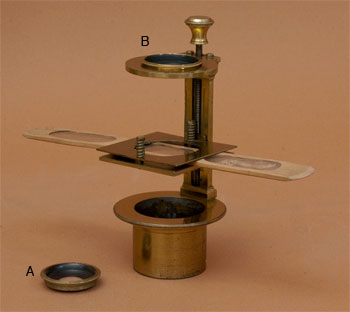
Optics of the solar microscope consist of a collector (or condenser) lens (A) inserted at the base of the conical body tube, two projection lenses (B, dia=33mm, f=12.5 or 7.9cm), and several eyepiece lens systems. Shown here (C) is the Screwbarrel microscope accessory. Additional magnification systems are the reflected light system (below, L) and the low-magnification projection system (below R).


Accessory for viewing opaque samples using reflected light. Light from the collecting lens (via the mirror) is reflected onto the sample (A). The medium magnification eyepiece lens (B) would be inserted in the threaded hole (C). The eyepiece lens is a Ramsden-type, optic consisting of two plano-convex lenses (curved surfaces facing inward), dia=15mm, combined f=65mm. Since Ramsden invented this eyepiece design in 1782, this lens may be a later addition, or (more likely) the microscope was made later than 1782.
Low-magnification projection lens for the solar microscope. As with the other two optics, this system presses onto the conical body tube. Sunlight shinning through the sample is projected onto a wall via either of the two supplied long working distance lenses. A: dia=13mm, f=29mm; B: dia=29mm, f=40mm.